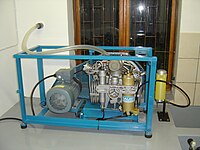
Photo from wikipedia
In the present study, the performance of H2‐metal hydrides‐based (HSRS) and CO2‐adsorbent‐based refrigeration systems (CSRS) are investigated and compared. The pair of metal hydrides (MH) used for HSRS is La0.9Ce0.1Ni5‐LaNi4.7Al0.3… Click to show full abstract
In the present study, the performance of H2‐metal hydrides‐based (HSRS) and CO2‐adsorbent‐based refrigeration systems (CSRS) are investigated and compared. The pair of metal hydrides (MH) used for HSRS is La0.9Ce0.1Ni5‐LaNi4.7Al0.3 whereas, for CSRS, it is Activated Carbon – Pore Expanded Mesoporous Silica (PEMS) adsorbents. The above pairs are chosen due to their suitability toward the sorption refrigeration system, which results from the screening of different pairs. The performances of these systems are investigated through the thermodynamic simulation as well as computational fluid dynamics (CFD) approach. The thermodynamic cycles of both the systems are analyzed for the operating temperatures of 0°C (Tr; refrigeration), 25°C (Ta; heat sink), and 100°C (Ts; heat source). Upon thermodynamic simulation, the refrigeration output, coefficient of performance (COP), specific refrigeration power, and second law efficiency are observed as 87.04 kJ, 0.91, 24.17 W/kg, and 41.6% for HSRS whereas, it is 49.32 kJ, 0.72, 20.55 W/kg, and 33.1% for CSRS, respectively, using 0.5 kg of each alloy. The CFD simulation results in the behavior of absorbent/adsorbent beds concerning temperature and gas mass variations. The minimum bed temperature is observed to be −31°C in HSRS, which is lower than that of CSRS (i.e., ‐9°C). The overall cycle time is predicted to be 3600 seconds for HSRS and 2400 seconds for CSRS. The shorter cycle time in CSRS is due to the high‐pressure differential between coupled beds during reactions and higher reaction rates of adsorbent materials than metal hydrides. Though CSRS possessed shorter cycle time, HSRS is found to be more suitable for refrigeration application due to better thermodynamic performance, in the given operating temperature range. Besides, the influence of variations in operating temperatures on the system performance is investigated and obtained the optimum temperature range of Tr = 5°C, Ta = 20°C, and Ts = 95°C. Finally, the thermodynamic performances of HSRS, CSRS, and CO2‐based vapor adsorption refrigeration system (CO2 VARS) are compared and observed that HSRS possessed better refrigeration performance among three.
Journal Title: International Journal of Energy Research
Year Published: 2020
Link to full text (if available)
Share on Social Media: Sign Up to like & get
recommendations!